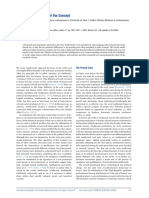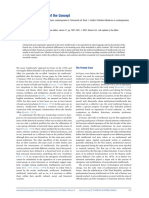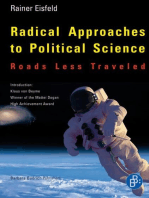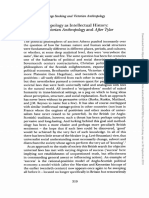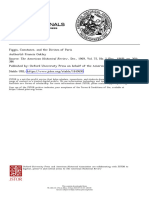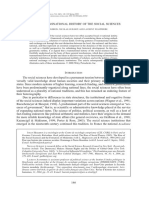H Net Reviews
H Net Reviews
Uploaded by
master_ovidiusCopyright:
Available Formats
H Net Reviews
H Net Reviews
Uploaded by
master_ovidiusCopyright
Available Formats
Share this document
Did you find this document useful?
Is this content inappropriate?
Copyright:
Available Formats
H Net Reviews
H Net Reviews
Uploaded by
master_ovidiusCopyright:
Available Formats
H-Net Reviews
http://www.h-net.org/reviews/showrev.php?id=35680
Wolf Feuerhahn, Pascale Rabault-Feuerhahn. La Fabrique Internationale de la Science: Les Congrs Scientifiques de 1865 1945. Paris: CNRS ditions, 2010. 258 S. (paper), ISBN 978-2-271-07096-8. Reviewed by Helke Rausch Published on H-Soz-u-Kult (March, 2012) W. Feuerhahn (Hrsg.): La Fabrique Internationale de la Science That Internationalism did not have to wait for the end of World War II to occupy the centre stage of politics and culture is a prevalent insight among historians. Yet precisely when, and more particularly how, international practices and the expansion of nongovernmental international organizations and transnational networks took shape is still widely debated. Accordingly, scientific congresses, especially before and after the Great War, would seem to be an obvious topic worthy of closer examination. Indeed, they can be identified as key fora of international activities, partly mirroring and partly shaping processes of modernisation, especially around the turn of the early 20th century, when global interconnections accelerated and professional actors multiplied around the world. Of the thirteen contributions in this volume, ten deal primarily with the pre-World War I era, while the remaining three address the interwar years. Marc-Antoine Kaesers essay starts off by describing how internationalisation at the Congrs international darchologie et danthropologie prhistorique in 1865 helped to enforce a modern evolutionary paradigm, while the discipline professionalised along decidedly national lines. Marie-Claire Robic shows that the international geographical conferences in the roughly hundred years following 1871 hardly proved to be places of paradigmatic transfers, but were instead repeatedly hampered by misunderstandings and opposing national interests. Pascale Rabault-Feuerhahn illustrates how international ambitions at the international congresses of Orientalists between 1871 and 1912 were inflamed under the banner of traditional European visions of Orientalism and thus failed to include academics outside Europe. Leaving all national differences and varying political agendas aside, Christine Laurire shows how International Congresses of Americanists between 1875 and 1947 helped their propagators to get American Studies institutionalised even before the subject was accredited at the university level. Arie L. Molendijk identifies international efforts to emancipate the discipline from traditional theology in response to the first International Congresses on the History of Religion in the late 19th century. Two subsequent chapters focus more closely on the importance of individual scholars on the stages of international congresses. Heinrich Dilly points to instances of cross-national intellectual transfers on the occasion of International Congresses of the History of Art. In stressing the prevalence of the collective transfer contexts, he eventually succeeds in deconstructing the myth of the allegedly genius single scholar. Anne-Marie Dcaillot follows up with a study on the German mathematician Georg Cantor, whose internationalism around the 1890s was instrumental in obtaining recognition for theories that had been widely marginalized in his own national scientific community. Wolf Feuerhahn identifies the Congress of Arts and Science of Saint Louis in 1904 as a forum for close German-American transfers. If the chief congressional aim, however, was to prevent academic knowledge from becoming fragmented, it largely failed. Franklin J. Lambert identifies internationalisation as the prime driving force behind the development of quantum physics. Gangolf Hbinger, Barbara Picht and Ewa Dabrowska demonstrate how participants of the international congresses of Historians between the turn of the century and 1913 engaged in international knowledge transfers. They did so not necessarily by agreeing with each other, but rather by intensely discussing whether their discipline should either legitimize national regimes or instead refine its methodology in order to stand apart from nationalist historiography. The final three essays look beyond the divide of the Great War. Roswitha Reinbothe highlights a key moment of failed internationalism when German scientists were excluded from international scientific cooperation in the aftermath of the war. Agnes Blnsdorf shows how the Comit International des Sciences Historiques founded in 1926 tried to come to terms with interwar efforts towards nationalization. Finally, Sandrine
1 von 3
15.03.2012 18:46
H-Net Reviews
http://www.h-net.org/reviews/showrev.php?id=35680
Maufroy outlines how the strong interwar tensions in the Balkans and in Russia made the Congresses of Byzantine Studies in Bucarest, Belgrade, Athens and Sofia during the 1920s and 1930s places of heated debate, which greatly interfered with the internationalist claims of the discipline. Although individual chapters of the collection cover quite distinct ground, three major themes clearly emerge. First, political contexts mattered significantly. Scientific internationalism was far from being a mere exercise in mutual cooperation, as it was continually threatened by competitive nationalism, both before and after the Great War. The full effect of this trend unsettled the internationalist credo and practice of its participants. This was especially the case during the interwar period, when scientific internationalism tended to conceal anti-Russian and more particularly Germanophobic attitudes, which generally stemmed from Germanys disagreeable political power. Second, scientific congresses in this period appear as highly complex institutional infrastructures with an enormous bureaucratic apparatus, increasingly professionalised methods of written and oral communication and rather nuanced modes of exchange and discussion. Moreover, in the age of mass culture, public appeal was a crucial element of congressional self-presentation, which was aimed at ensuring that policy makers would listen to the academic crowd. Scientists often hoped to occupy strategic positions when it came to defining contemporary political agendas. Third, scientific congresses were epistemological endeavours in their own right, with academics fighting to establish so-called respectable scholarly disciplines. As in the case of politics, institutionalisation and standardisation processes at times proved to be competitive endeavours between rivalling individuals and schools in search of strategic dominance in their respective disciplinary field or chosen methodology. While the volume covers a broad range of issues, some aspects are unavoidably ignored. Pointing these out does not discount the volumes merits, but instead helps to illuminate some blind spots in the current research agenda. When and why, for example, would any one of the three crucial aspects of international scientific congresses mentioned above (politics, infrastructures, discipline formation) prove more vital than others during specific time periods in the era investigated from the mid-19th to the mid-20th century (and in fact beyond)? Did scientific internationalism even exist, so that there was an identifiable set of (a)political and (non)ideological components irrespective of the relevant discipline and actors involved? Apart from such systematic longue dure accounts, we need to connect congressional scientific internationalism to parallel and comparable signs of internationalism, most visibly expressed in the plethora of highly diverse nongovernmental organisations that have been founded since the late 19th century. Where and how did these phenomena overlap, and would this, finally, prove there were remnants of civil society even in the wake of the war or rather point to the fact that scientific internationalism was politically indifferent? Even though this collected volume, quite legitimately, is not meant to exhaust the topic, it provides a panorama of the intricacies of scientific internationalism. It conveys the impression that congressional activities since around the turn of the century were simultaneously instances of transnational hyperactivism and nationalistic partition. In a way, scientific congresses seem to have kept internationalism in ironic suspense.
If there is additional discussion of this review, you may access it through the list discussion logs at: http://h-net.msu.edu/cgi-bin/logbrowse.pl. Citation: Helke Rausch. Review of Feuerhahn, Wolf; Rabault-Feuerhahn, Pascale, La Fabrique Internationale de la Science: Les Congrs Scientifiques de 1865 1945. H-Sozu-Kult, H-Net Reviews. March, 2012. URL: http://www.h-net.org/reviews/showrev.php?id=35680 Copyright 2012 by H-Net, Clio-online, and the author, all rights reserved. This work may be copied and redistributed for non-commercial, educational purposes, if permission is granted by the author and usage right holders. For permission please contact H-SOZU-KULT@H-NET.MSU.EDU.
Humanities & Social Sciences Online
2 von 3
15.03.2012 18:46
H-Net Reviews
http://www.h-net.org/reviews/showrev.php?id=35680
Copyright 1995-2012 - Contact Us RSS | Validate: HTML | CSS
3 von 3
15.03.2012 18:46
You might also like
- Keene Edward - International Political Thought - CompletoDocument236 pagesKeene Edward - International Political Thought - CompletoBe Better Smart100% (1)
- Resort Business PlanDocument42 pagesResort Business Plansalesbaliharmony100% (1)
- Knutsen-The Origins of International Relations - Idealists, Administrators and The Institutionalization of A New Science PDFDocument19 pagesKnutsen-The Origins of International Relations - Idealists, Administrators and The Institutionalization of A New Science PDFYolima Novoa HernandezNo ratings yet
- The Place of Historiography in The Network of Logical EmpiricismDocument26 pagesThe Place of Historiography in The Network of Logical EmpiricismOm HasaniNo ratings yet
- Wittrock Social Theory and Intellectual History (2) - 1-20Document20 pagesWittrock Social Theory and Intellectual History (2) - 1-20Mário CamposNo ratings yet
- Chapter 1Document13 pagesChapter 1roanneiolaveNo ratings yet
- 5545 5626 PDFDocument14 pages5545 5626 PDFTheodor Ludwig AdornoNo ratings yet
- Introduction. Postmodernism and The French EnlightenmentDocument7 pagesIntroduction. Postmodernism and The French EnlightenmentZdravko JovanovicNo ratings yet
- HH RoundaboutDocument9 pagesHH RoundaboutHerbert HrachovecNo ratings yet
- The Austrian Mind: An Intellectual and Social History, 1848-1938From EverandThe Austrian Mind: An Intellectual and Social History, 1848-1938No ratings yet
- Jewish Weimar RepublicDocument17 pagesJewish Weimar RepublicRaúlNo ratings yet
- Consensus in Conflict The Making of A Common Intellectual Culture in Germany-Simon+Unger+-+DPhil+Final+Post+VivaDocument402 pagesConsensus in Conflict The Making of A Common Intellectual Culture in Germany-Simon+Unger+-+DPhil+Final+Post+VivaLibertySeaNo ratings yet
- Aula 10 Van Alstein - 2009 - The Meaning of Hostile Bipolarization Interpreting The Origins of The Cold War (2) Aula10Document14 pagesAula 10 Van Alstein - 2009 - The Meaning of Hostile Bipolarization Interpreting The Origins of The Cold War (2) Aula10Rodrigo SpinolaNo ratings yet
- Meaning of Hostile Bipolarisation-Interpreting The Origins of The Cold WarDocument20 pagesMeaning of Hostile Bipolarisation-Interpreting The Origins of The Cold WarCon_FuciusNo ratings yet
- Mink 1966Document25 pagesMink 1966Tiago AlmeidaNo ratings yet
- Global Fascism Geography Timing Support and StrategyDocument22 pagesGlobal Fascism Geography Timing Support and Strategyfb101406No ratings yet
- H. Turner, Fascism and ModernizationDocument19 pagesH. Turner, Fascism and ModernizationGelu Cristian SabauNo ratings yet
- Paper No 2 (French Scholarship)Document8 pagesPaper No 2 (French Scholarship)Joar De Lima ConchaNo ratings yet
- Fascism and Philosophy: The Case of Actualism: Fogu, Claudio, 1963Document20 pagesFascism and Philosophy: The Case of Actualism: Fogu, Claudio, 1963Seed Rock ZooNo ratings yet
- Logical Empiricism & The Philosophy of Science (Alan Richardson)Document4 pagesLogical Empiricism & The Philosophy of Science (Alan Richardson)René CampisNo ratings yet
- Institutionalisation of Disciplines - HistoryDocument11 pagesInstitutionalisation of Disciplines - Historyshweta sinhaNo ratings yet
- Gunzburg, Clues and Scientific MethodDocument32 pagesGunzburg, Clues and Scientific MethodJason KingNo ratings yet
- One Discipline, Four Ways: British, German, French, and American AnthropologyFrom EverandOne Discipline, Four Ways: British, German, French, and American AnthropologyRating: 4 out of 5 stars4/5 (1)
- Adams, M, Jun, N Political Theory and History The Case of AnarchismDocument20 pagesAdams, M, Jun, N Political Theory and History The Case of AnarchismНатали ШуляковаNo ratings yet
- Philosophy of Action - Philosophie de L'action (PDFDrive)Document372 pagesPhilosophy of Action - Philosophie de L'action (PDFDrive)Marta100% (1)
- Journal Renaissance To EnlightenmentDocument11 pagesJournal Renaissance To EnlightenmentardiazaidNo ratings yet
- The Magic of The National Ag: Ethnic and Racial Studies February 2016Document20 pagesThe Magic of The National Ag: Ethnic and Racial Studies February 2016brainhub50No ratings yet
- The French Revolution in Cultural HistoriesDocument11 pagesThe French Revolution in Cultural HistoriesNitin VermaNo ratings yet
- The Invention of International Relations Theory: Realism, the Rockefeller Foundation, and the 1954 Conference on TheoryFrom EverandThe Invention of International Relations Theory: Realism, the Rockefeller Foundation, and the 1954 Conference on TheoryNo ratings yet
- Steinmetz (2018) - How and Why Do We Write The History of The Social SciencesDocument10 pagesSteinmetz (2018) - How and Why Do We Write The History of The Social Sciencesjpmagabo09No ratings yet
- French Revolution Political HistoriographyDocument11 pagesFrench Revolution Political HistoriographyRishali Chauhan 84No ratings yet
- History and Cultural Theory. Simon Gunn. Chapters 1 and 2.Document10 pagesHistory and Cultural Theory. Simon Gunn. Chapters 1 and 2.Leticia ZuppardiNo ratings yet
- Intellectuals: History of The ConceptDocument4 pagesIntellectuals: History of The ConceptGECJ100% (1)
- Marc Raeff - Estado de Polícia - 1975Document24 pagesMarc Raeff - Estado de Polícia - 1975Arnaldo V. CarvalhoNo ratings yet
- The Artistic and Political Repercussions of The French RevolutionDocument7 pagesThe Artistic and Political Repercussions of The French Revolutionapi-341237835No ratings yet
- Intellectuals: History of The ConceptDocument4 pagesIntellectuals: History of The ConceptRanjan Kumar SinghNo ratings yet
- From Mutual Observation to Propaganda War: Premodern Revolts in Their Transnational RepresentationsFrom EverandFrom Mutual Observation to Propaganda War: Premodern Revolts in Their Transnational RepresentationsMalte GriesseNo ratings yet
- Historicismo - Notas Sobre Um Paradigma Antiteses 2012Document28 pagesHistoricismo - Notas Sobre Um Paradigma Antiteses 2012JuninhosanNo ratings yet
- Radical Approaches to Political Science: Roads Less TraveledFrom EverandRadical Approaches to Political Science: Roads Less TraveledNo ratings yet
- HoME II - IA IDocument10 pagesHoME II - IA IRemin KabakNo ratings yet
- History and Theory Volume 3 Issue 3 1964 (Doi 10.2307/2504234) George H. Nadel - Philosophy of History Before HistoricismDocument26 pagesHistory and Theory Volume 3 Issue 3 1964 (Doi 10.2307/2504234) George H. Nadel - Philosophy of History Before HistoricismAlvareeta PhanyaNo ratings yet
- Die Schulpolitik Des Faschistischen Regimes in by Annas ArchiveDocument3 pagesDie Schulpolitik Des Faschistischen Regimes in by Annas ArchiveGabriel VanderNo ratings yet
- Macuglia 14Document35 pagesMacuglia 14Alberto DíazNo ratings yet
- JV CultDocument10 pagesJV Cultmingeunuchbureaucratgmail.comNo ratings yet
- Introduction The State of The ArtDocument34 pagesIntroduction The State of The ArtvchronicNo ratings yet
- Megill, Allan - Foucault, Structuralis, and Ends of HistoryDocument54 pagesMegill, Allan - Foucault, Structuralis, and Ends of HistoryRoberto Nación PantigosoNo ratings yet
- Philosophy of The ReformationDocument30 pagesPhilosophy of The ReformationGraecaLatinaNo ratings yet
- 1996 Diaz-Andreu & ChampionDocument22 pages1996 Diaz-Andreu & ChampionMuris ŠetkićNo ratings yet
- 28-63-1-SM Civilisation On Trial PDFDocument34 pages28-63-1-SM Civilisation On Trial PDFsakic100% (3)
- KATER M. H. - Rezension - Der Führerstaat Mythos & RealitätDocument4 pagesKATER M. H. - Rezension - Der Führerstaat Mythos & RealitätPeter WilhelmNo ratings yet
- The Oxford Handbook of World History by Jerry H. Bentley (Z-Lib - Org) - 30-149Document120 pagesThe Oxford Handbook of World History by Jerry H. Bentley (Z-Lib - Org) - 30-149el and coNo ratings yet
- 3.2.a-The Social Context of ScienceDocument23 pages3.2.a-The Social Context of Sciencejjamppong09No ratings yet
- Oakley FiggisConstanceDivines 1969Document20 pagesOakley FiggisConstanceDivines 1969crbsiegfriedNo ratings yet
- HS 259 2013Document20 pagesHS 259 2013smaguerraNo ratings yet
- Writing 20th Century International History: Explorations and ExamplesFrom EverandWriting 20th Century International History: Explorations and ExamplesNo ratings yet
- Regarding Politics: Essays on Political Theory, Stability, and ChangeFrom EverandRegarding Politics: Essays on Political Theory, Stability, and ChangeNo ratings yet
- Gmat 3Document47 pagesGmat 3harshsrivastavaalldNo ratings yet
- History of World 24Document23 pagesHistory of World 24Bhavtosh SharmaNo ratings yet
- Historical Materialism 24.1 (2016)Document236 pagesHistorical Materialism 24.1 (2016)Txavo HesiarenNo ratings yet
- The Canon of The History of Political Thought - Its Critique and A Proposed Alternative PDFDocument21 pagesThe Canon of The History of Political Thought - Its Critique and A Proposed Alternative PDFFrancisMontyNo ratings yet
- HEILBRON. Toward A Transnational History of The Social Sciences PDFDocument15 pagesHEILBRON. Toward A Transnational History of The Social Sciences PDFLucasTrindade88No ratings yet
- New Histories of The United NationsDocument25 pagesNew Histories of The United Nationsmaster_ovidiusNo ratings yet
- Web Revcache Review 39975Document4 pagesWeb Revcache Review 39975master_ovidiusNo ratings yet
- Web Revcache Review 40101Document3 pagesWeb Revcache Review 40101master_ovidiusNo ratings yet
- LAQUA Internationalism Reconfigured 2011Document2 pagesLAQUA Internationalism Reconfigured 2011master_ovidiusNo ratings yet
- Maths PDFDocument4 pagesMaths PDFrthirupaNo ratings yet
- Rahul CV-1Document1 pageRahul CV-1mkshmistryNo ratings yet
- Invigilator Roles and ResponsibilitiesDocument38 pagesInvigilator Roles and ResponsibilitiesAsif Yaqub Khan100% (1)
- 2020 Paper 4Document13 pages2020 Paper 4Vikas KaushikNo ratings yet
- MeridiansDocument2 pagesMeridianspraveen_128No ratings yet
- Project Proposal CWTSDPMDocument6 pagesProject Proposal CWTSDPMJacel Reinard ArceoNo ratings yet
- ZFP MEP BOQ Plumbing+Hvac1Document6 pagesZFP MEP BOQ Plumbing+Hvac1Omar MhmmadNo ratings yet
- The Oxford College of Engineering SSRDocument303 pagesThe Oxford College of Engineering SSRvmspraneeth100% (1)
- Yealink - SIP-T21P-E2 - Datasheet - by LATNOK CDDocument2 pagesYealink - SIP-T21P-E2 - Datasheet - by LATNOK CDCoko Mirindi MusazaNo ratings yet
- SM1001902Document110 pagesSM1001902Rahul barodNo ratings yet
- EcumenismDocument55 pagesEcumenismJessie OcampoNo ratings yet
- Pre Writing Info SheetDocument6 pagesPre Writing Info SheetkellykidmanNo ratings yet
- 14POS06 - In-Flight Incapacitation - Flight Crew TrainingDocument2 pages14POS06 - In-Flight Incapacitation - Flight Crew TrainingpedatiNo ratings yet
- City FormDocument7 pagesCity FormRalph Vincent Valdez TamangNo ratings yet
- Research EssayDocument14 pagesResearch EssayDhara RakholiyaNo ratings yet
- Inert Gas SystemDocument9 pagesInert Gas Systemdj22500100% (3)
- FortiSandbox-4 2 3-Administration - GuideDocument238 pagesFortiSandbox-4 2 3-Administration - GuideForTest TestForeNo ratings yet
- Tesco Plans To Open Las Vegas SupermarketsDocument2 pagesTesco Plans To Open Las Vegas SupermarketsHuong NguyenNo ratings yet
- Mmi Um013 - en PDocument148 pagesMmi Um013 - en PtaharNo ratings yet
- Psychrometric Processes NumericalsDocument16 pagesPsychrometric Processes NumericalsDHADKAN K.C.No ratings yet
- Redox Flow Battery PDFDocument9 pagesRedox Flow Battery PDFpedro_cabezas_2No ratings yet
- Chemistry (Determination of Contents of Cold Drinks) - 1Document22 pagesChemistry (Determination of Contents of Cold Drinks) - 1StudenrtNo ratings yet
- Problem Solving Using IRACDocument9 pagesProblem Solving Using IRACthroux100% (1)
- Factsheet 210129 36 IdxinfraDocument1 pageFactsheet 210129 36 IdxinfraNeedlaregNo ratings yet
- Generic PPT 5807 5808Document23 pagesGeneric PPT 5807 5808Angel BeronioNo ratings yet
- Topic 6 - PRINCIPLES OF FERTILIZER USEDocument54 pagesTopic 6 - PRINCIPLES OF FERTILIZER USEGretz AnticamaraNo ratings yet
- Yeast and Mold Spoilage in Dairy ProductsDocument4 pagesYeast and Mold Spoilage in Dairy ProductsAngelica Alejandra De La Torre AnayaNo ratings yet
- Wstęp Do Językoznawstwa - NotatkiDocument14 pagesWstęp Do Językoznawstwa - NotatkijoannaaaaNo ratings yet
- l4 Complementary DietDocument45 pagesl4 Complementary DietNur Ainaa100% (1)
































